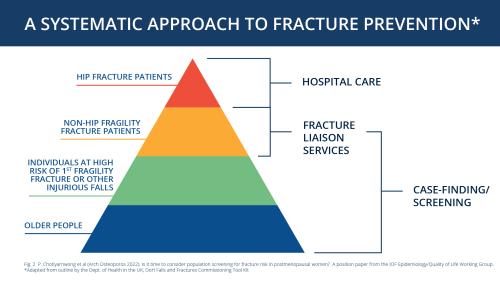LATEST NEWS
- All news
-
51Awards
-
9Burden of Osteoporosis
-
81Capture the Fracture
-
1Exercise
-
1FRAX
-
89IOF
-
36IOF Positions and Statements
-
1IOF Tour Latin America
-
23Meetings
-
78Member News
-
9Nutrition
-
39Policy
-
6Prevention
-
53Research
-
32Scientific Journals
-
14Skeletal Rare Diseases
-
9Training Courses
-
18Treatment
-
32World Osteoporosis Day
- News room - Latin America Region
Population screening for fracture risk: a logical step in reducing the osteoporotic fracture burden

The International Osteoporosis Foundation (IOF) Epidemiology and Quality of Life Working Group has reviewed the potential role of population screening for high hip fracture risk against well-established criteria. The multinational panel concludes that such an approach is cost-effective, has a proven potential to reduce the burden of hip fractures, and should strongly be considered in many health care systems, once strategies for optimal implementation have been determined.
Osteoporotic fractures are a major burden to society and healthcare systems worldwide. Hip fractures in particular result in significant morbidity, hospitalisation, surgery and prolonged rehabilitation, with many patients not returning to their pre-fracture level of mobility and independence. Nevertheless, the vast majority of people at high risk of osteoporotic fracture remain unidentified and untreated. One of the main reasons for this vast treatment gap, and a key barrier to an effective reduction in fracture rates, is the low awareness of osteoporosis amongst primary care physicians. The Working Group’s new position paper, 'Is it time to consider population screening for fracture risk in postmenopausal women?’ proposes a screening strategy to identify women at increased risk of hip fracture which would serve to reduce the treatment gap, and which could be adapted for implementation in healthcare systems worldwide. [1]
Co-Lead author, Professor Eugene McCloskey, stated:
“Osteoporosis and, specifically, its burden of fractures, represents an opportunity for consideration of a screening strategy in the primary care setting. Based on the approach undertaken in the Screening for Osteoporosis in Older People (SCOOP) study in the UK, we know that such a strategy can be a clinically- and cost-effective way to identify and treat women at high risk of hip fracture.”[2]
The position paper proposes a strategy based on assessment of hip fracture risk using the FRAX® risk assessment tool, which might be implemented in an automated fashion in primary care. Such approaches would permit automatic flagging of older individuals at high fracture risk, who could be identified for treatment with antiosteoporosis medications. The approach represents a step change from current practice in which risk assessment is only undertaken in response to a risk factor being identified in the clinic.
Professor Nicholas Harvey, co-author and Chair of the IOF Committee of Scientific Advisors, noted:
“An important question is how much added benefit would be gained by population screening over usual care and whether a population screening programme is cost-effective. The proposed strategy combines a low-cost assessment with targeted intervention using low-cost generic treatments, predominantly oral bisphosphonates. The subsequent 28% reduction in the incidence of hip fractures as shown in the SCOOP study is a highly impactful strategy compared to usual care. Even more importantly, the standard cost-effectiveness analysis demonstrates that the strategy is actually cost-saving.”
The panel includes experts with a wide breadth of expertise in the fields of risk assessment, guidelines, treatment and health economics of osteoporosis from 19 countries. The approach used attempted to measure the level of consensus on the various criteria from a wide variety of geographic and healthcare system settings.
In an Editorial (Population screening for fracture risk in postmenopausal women — a logical step in reducing the osteoporotic fracture burden?) which has been published in Osteoporosis International, Professor John Kanis, IOF Honorary President stated [3]:
“We would contend that the case for screening to identify women at increased risk of hip fracture is now made and that future research should focus on strategies for optimal implementation of this approach across different healthcare systems and settings. Any transition towards screening that leads to improved identification of hip fracture risk in older women in primary care will undoubtedly have positive impacts on the clinical, personal and economic burden of this most serious of osteoporotic fractures.”
“The position is meant to serve as a basis for engagement and discussion with policymakers and payers around the potential for screening in osteoporosis with a particular focus on high hip fracture risk.”
###
References
1. Chotiyarnwong, P., McCloskey, E.V., Harvey, N.C. et al. Is it time to consider population screening for fracture risk in postmenopausal women? A position paper from the International Osteoporosis Foundation Epidemiology/Quality of Life Working Group. Arch Osteoporos 17, 87 (2022). https://doi.org/10.1007/s11657-022-01117-6
2. Shepstone L, Lenaghan E, Cooper C, et al. (2018) Screening in the community to reduce fractures in older women (SCOOP): a randomised controlled trial. Lancet 391:741-747
https://www.thelancet.com/journals/lancet/article/PIIS0140-6736(17)32640-5/fulltext
3. McCloskey, E.V., Chotiyarnwong, P., Harvey, N.C. et al. Population screening for fracture risk in postmenopausal women — a logical step in reducing the osteoporotic fracture burden?. Osteoporos Int (2022). https://doi.org/10.1007/s00198-022-06419-6
About IOF
The International Osteoporosis Foundation (IOF) is the world's largest nongovernmental organization dedicated to the prevention, diagnosis, and treatment of osteoporosis and related musculoskeletal diseases. IOF members, including committees of scientific researchers as well as more than 300 patient, medical and research organizations, work together to make fracture prevention and healthy mobility a worldwide heath care priority. https://www.osteoporosis.foundation @iofbonehealth